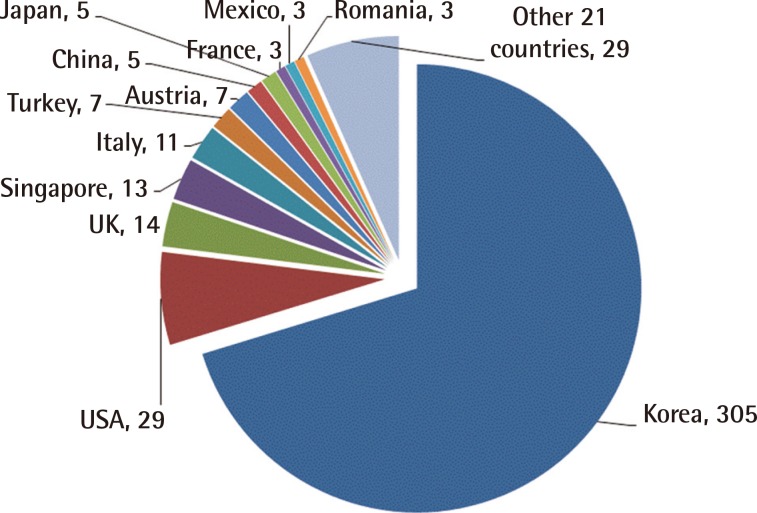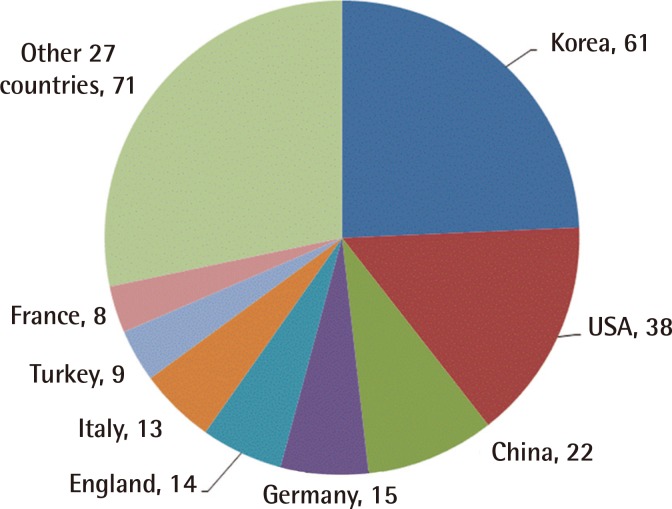How Journal Metrics Illustrate the Transformation of Archives of Plastic Surgery into an International Journal
Article information
In 2012, the official journal of the Korean Society of Plastic and Reconstructive Surgeons began publishing exclusively in English and changed its name to Archives of Plastic Surgery (APS). Through the contributions of the Editorial Board, reviewers, authors, and journal staff, APS has quickly transformed into a truly international journal, with authors and studies originating from all over the world.
Journal metrics-such as the number of articles, impact factor, citation frequency, citations per two years, Hirsch index, country of authors, and country of citing articles' authors-are often used to demonstrate quality and influence in academic publication. Although such metrics cannot fully describe the quality of research and ideas reported by the journal, the depth and breadth of the international academic community that has formed around its texts and practices, or the influence of the journal's content on clinical practice, they still provide important insights about the growth and development of a journal. Thus all these journal metrics were gathered and analyzed from Web of Science, SCImago Journal Ranking, Scopus, and KoreaMed Synapse. The proportion of the original articles that reported on research that had been funded was also calculated. The methods are the same as those used previously to analyze other journals based in Korea [1,2].
The results were interesting. The number of citable articles in Korean or English from the journal under its old title, Journal of the Korean Society of Plastic and Reconstructive Surgeons (JKSPRS), from Volume 18 (1991) to Volume 38 (2011) was 2,585. The number of articles from APS from Volume 39 (2012) to Volume 41 No. 4 (2014) was 352. From Web of Science, the number of citations of 21 years' worth of JKSPRS was 217 citations of 149 articles; strikingly, in less than 2 years' worth of APS publication, 280 citations of 135 APS articles occurred (up to September 2014). Therefore, the average number of citations per article for JKSPRS was 0.084, while that of APS was an order of magnitude higher, at 0.795. The citations per document (2 years) for APS from the 2013 SCImago Journal and Country Ranking, was 1.074. The SCImago Journal Rank indicator (SJR) was 0.424, which is a ranking of 178 out of 379 surgery journals (47.0%). The countries of authors published in APS from January 2012 to September 2014 are presented in Fig. 1. The countries of authors who cited APS from 2012 to September 2014 in Web of Science are shown in Fig. 2. The Hirsch index from Web of Science was 6 (Table 1), that from Scopus was 7 (Table 2), and that from DOI/CrossRef was 8 (Table 3). The number of funded research articles out of 199 original articles was 34 (17.1%).

Countries of authors publishing in Archives of Plastic Surgery from January 2012 to September 2014 [Cited 2014 Sep 19]

Countries of authors citing Archives of Plastic Surgery from 2012 to September 2014 in Web of Science [cited 2014 Sep 19]
For many years, the quality of the papers published in JKSPRS was not properly reflected in the journal metrics, not only because many articles were written in Korean, but also because the journal had not been indexed in the appropriate platforms. On the other hand, although 305 out of 387 articles published in APS during the study period were written by Korean researchers, with the English-language journal's broader exposure, its authors have been affiliated with 33 countries (Fig. 1). Furthermore, the authors who cited APS were from 35 countries (Fig. 2), which shows that APS has excellent exposure to readers around the world. The difference in the Hirsch index calculated from each of three databases, Web of Science, Scopus, and DOI/CrossRef, originated from the number of journals and papers covered by the databases. Usually the Hirsch index from DOI/CrossRef is the highest, which corroborates the results found for APS [3]. The proportion of funded articles was rather low, which was not surprising, given that much of APS addresses clinical phenomena, not basic studies.
Among the factors that have influenced the radical change in journal metrics, the change in the language might be the most important. In addition, in order to encourage citation by other researchers, the platform has been found to be more important than the open access policy [4]. Since PubMed is the most important database platform in medical research, being listed in PubMed is critical for exposure to an international readership. When the journal is chosen to be included in PubMed Central, it can be indexed in PubMed. PubMed Central only accepts medical journals in English with an acceptable quality of Journal Article Tag Suite XML [5,6,7]. If a journal is not included in PubMed Central, being indexed in PubMed requires being selected for MEDLINE, which has become increasingly exclusive. Thus it is particularly valuable that APS was chosen for PubMed Central on its own merits, including its language and quality.
Almost all major medical journals in Korea, including APS, have adopted the following policies and processes: first, changing the language of the journal to English only [8]; second, publishing with open access according to Creative Commons licensing guidelines; third, producing full-text Journal Article Tag Suite (JATS) XML; fourth, depositing XML files to PubMed Central and ScienceCentral; fifth, asking PubMed Central to deposit XML in PubMed; and finally, actively recruiting authors from outside Korea. APS has been searchable from PubMed Central and PubMed since July 12, 2012. APS has already provided a digital object identifier, CrossMark, and FundRef for each article [9,10], so Open Researcher and Contributor ID (ORCID) is the next tool to be included [11], following international standards. Audio or video files should also be posted on the APS website to increase the visibility of the articles [12].
The development of APS up to its present level of quality and exposure has been made possible by changing the language of the journal to English, producing full-text JATS XML files, and depositing those files to PubMed Central. Therefore, the decision of the Board of Directors of the Korean Society of Plastic and Reconstructive Surgeons in 2011 to change the language of the official journal from Korean to English only beginning with the 2012 issues was a milestone in the journal's history.
Notes
This work is supported by a research grant of the Korean Federation of Science and Technology Societies (KOFST-2014), government of the Republic of Korea.
No potential conflict of interest relevant to this article was reported.


